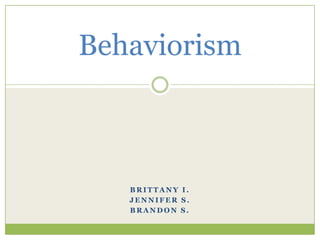
Behaviorism presentation
- 1. Behaviorism BRITTANY I. JENNIFER S. BRANDON S.
- 2. Behaviorism “Behaviorism is the prediction and control of human behavior in which introspection and/or independent thinking play no essential part of its teaching methods” (Shelley 258) The student is “essentially passive” and acts in response to stimuli (Learning Theories Knowledgebase Behaviorism includes operant and classical conditioning, as well as positive and negative reinforcement.
- 3. Ivan Pavlov Ivan Pavlov (1849 – 1936) was a Russian scientist that won the Nobel Prize in Physiology in 1904. Pavlov was most known for his use of classical conditioning to train dogs to salivate at the ring of a bell. Classical conditioning: “refers to the natural reflex that occurs in response to stimulus” (Shelley 258)
- 4. B.F. Skinner B.F. Skinner (1904 – 1990) was an American scientist most known for his use of operant conditioning Operant conditioning: “describes learning that is controlled and results in shaping behavior through the reinforcement of stimuli-response patterns” (Shelley 259) Begins with a stimulus, ends in a reward, either positive or negative Skinner conducted experiments in which he rewarded pigeons when they behaved in a correct way He concluded that people “shape their behavior based on the rewards or positive reinforcement they receive” (Shelley 259)
- 5. Behaviorism and Teachers Behaviorism puts the teacher at the forefront of the learning experience and “implies the dominance of the teacher” (learningandteaching.info). In a behaviorist classroom, the teacher would be responsible for affecting the behavior of the students, possibly by implementing classical or operant conditioning. Technology has been developed that utilizes operant conditioning; computer games or apps use positive reinforcement to encourage student learning
- 6. Behaviorism and Students For students, behaviorism puts student behavior in the hands of the instructor. Using iPad applications or computer games encourage student learning through operant conditioning. Other ways of using behaviorism with students include giving out candy or extra credit for certain behaviors This can also go the opposite way: using detention or some other sort of punishment to affect students when they act out of line
- 7. Behaviorism and Us We feel that there are good things and bad things about behaviorism. The Good: Operant conditioning is a great way to influence student behavior, especially with positive reinforcement. The Bad: It puts too much emphasis on the teacher and not enough on the student. Too much influence from the teacher could cause conflicts with parents.
- 8. Sources Image of Pavlov: http://faith-happens.com/wp- content/uploads/2012/10/pavlov-experiment-dog.jpg Image of Skinner: http://www.harvardsquarelibrary.org/stafford/images/bfskinne r.jpg Images of children with iPads: http://www.nytimes.com/2011/01/05/education/05tablets.html http://www.ipadsforeducation.vic.edu.au/userfiles/images/TB_042_20101 213_HP_4444.jpg http://www.learningandteaching.info/learning/behaviour.htm http://www.learning-theories.com/behaviorism.html Teachers Discovering Computers: Integrating Technology in a Connected World. Shelly|Gunter|Gunter. Pages 258-260